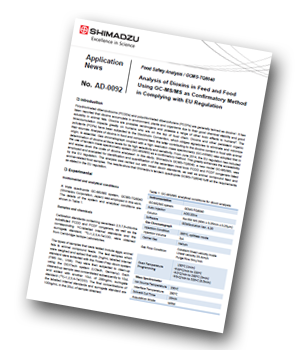Shimadzu has produced an application note describing the analysis of dioxins in feed and food using GC-MS/MS as a confirmatory method in complying with EU regulations.
 Introduction
Introduction
Polychlorinated dibenzodioxins (PCDDs) and polychlorinated dibenzofurans (PCDFs) are generally termed as dioxins. It has been reported that dioxins accumulate in the environment, plants and organisms due to their good chemical stability and good solubility in animal fats.
Since June 2014, the EU regulation has included the use of tandem mass spectrometry system (GC-MS/MS) as a confirmatory method for the determination of dioxins.
Experimental
In this study, Shimadzu’s GCMS-TQ8040 was employed for the identification and quantification of the seventeen most toxic PCDD and PCDF congeners listed by the EU regulation. The analysis was carried out with mixed dioxin standards, as well as animal compound feed and animal-related food samples.
Results and Discussion
For unequivocal determination of dioxins in feed and food by using GC-MS/MS, several requirements have been amended in the commission regulation (EU) No. 589/2014. These modifications include the limit of quantification of individual congeners and new specific requirements for confirmatory methods. These, along with some other basic requirements, are evaluated in this study.
Conclusion
The Shimadzu GCMS-TQ8040 and the MRM method established on it are capable of detection and quantitation of seventeen regulated dioxins with high sensitivity and selectivity. The results show that the method and system meet the requirements as stated in the EU regulation for confirmatory analysis of dioxins in feed and food.




